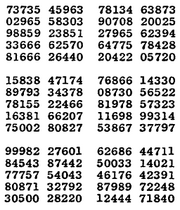How To Use Random Number Table
Cess | Biopsychology | Comparative | Cerebral | Developmental | Linguistic communication | Individual differences | Personality | Philosophy | Social |
Methods | Statistics | Clinical | Educational | Industrial | Professional items | Earth psychology |
Statistics: Scientific method · Enquiry methods · Experimental pattern · Undergraduate statistics courses · Statistical tests · Game theory · Conclusion theory
Random number tables take been used in statistics for tasks such as selected random samples. This was much more than constructive than manually generating selecting the random samples (with dice, cards, etc.). Nowadays, tables of random numbers have been replaced by computational random number generators.

A random sampling of 300 random digits from RAND'southward 1955 A Meg Random Digits with 100,000 Normal Deviates .
Tables of random numbers accept the desired properties no matter how chosen from the tabular array: by row, cavalcade, diagonal or irregularly. The outset such table was published past a student of Karl Pearson'due south in 1927, and since then a number of other such tables were developed. The first tables were generated through a multifariousness of ways—one (by L.H.C. Tippett) took its numbers "at random" from census registers, another (by R.A. Fisher and Francis Yates) used numbers taken "at random" from logarithm tables, and in 1939 a set of 100,000 digits were published past M.Chiliad. Kendall and B. Babington Smith produced past a specialized machine in conjunction with a man operator. In the mid-1940s, the RAND Corporation set virtually to develop a large tabular array of random numbers for utilize with the Monte Carlo method, and using a hardware random number generator produced A Million Random Digits with 100,000 Normal Deviates . The RAND table used electronic simulation of a roulette wheel fastened to a computer, the results of which were then carefully filtered and tested earlier beingness used to generate the table. The RAND table was an important breakthrough in delivering random numbers because such a large and carefully prepared table had never before been available (the largest previously published table was x times smaller in size), and because it was also available on IBM dial cards, which allowed for its utilise in computers. In the 1950s, a hardware random number generator named ERNIE was used to draw British lottery numbers.
The offset "testing" of random numbers for statistical randomness was developed by Yard.Thousand. Kendall and B. Babington Smith in the late 1930s, and was based upon looking for sure types of probabilistic expectations in a given sequence. The simplest examination looked to make sure that roughly equal numbers of 1s, 2s, 3s, etc. were present; more than complicated tests looked for the number of digits between successive 0s and compared the full counts with their expected probabilities. Over the years more complicated tests were developed. Kendall and Smith also created the notion of local randomness , whereby a given gear up of random numbers would be broken downwards and tested in segments. In their set of 100,000 numbers, for instance, two of the thousands were somewhat less "locally random" than the residual, but the prepare equally a whole would pass its tests. Kendall and Smith advised their readers not to use those particular thousands by themselves as a consequence.
If carefully prepared, the filtering and testing processes remove any noticeable bias or asymmetry from the hardware-generated original numbers so that such tables provide the nigh 'reliable' random numbers bachelor to the coincidental user.
Annotation that any published (or otherwise attainable) random information table is unsuitable for cryptographic purposes since the accessibility of the numbers makes them effectively predictable, and hence their effect on a cryptosystem is also anticipated. By way of contrast, genuinely random numbers that are but attainable to the intended encoder and decoder let literally unbreakable encryption of a similar or lesser amount of meaningful data (using a elementary exclusive-OR operation).
External links
- Data from A Million Random Digits With 100,000 Normal Deviates by the RAND Corporation
How To Use Random Number Table,
Source: https://psychology.fandom.com/wiki/Random_number_table
Posted by: tusseyfalf1986.blogspot.com


0 Response to "How To Use Random Number Table"
Post a Comment